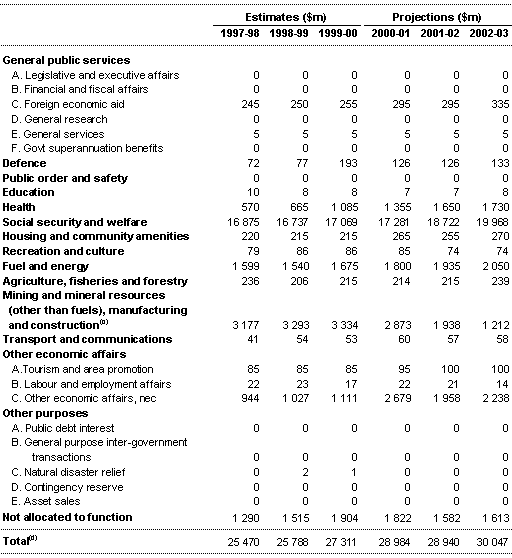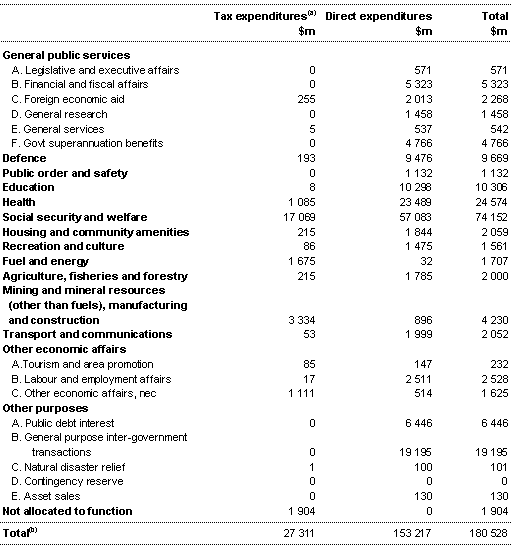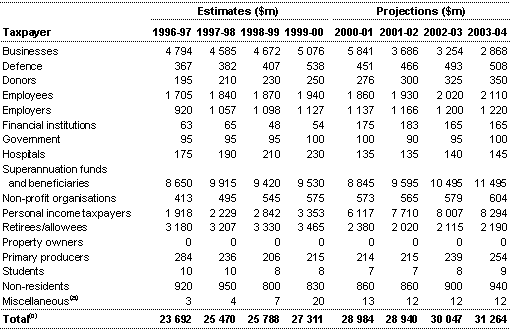2.1 Introduction
Tax expenditure aggregates are reported and analysed in this chapter, with a breakdown of tax expenditures by both function and taxpayer affected. Care must be taken when interpreting these aggregates, particularly when making comparisons across time. There are several major considerations that need to be taken account of when analysing tax expenditure aggregates.
- First, some of the identified tax expenditures are not costed because of a lack of suitable data. Hence, tax expenditure aggregates will tend to underestimate the total benefit provided by tax expenditures.
- Second, the trend in aggregates over time will reflect both changes in the cost of individual tax expenditures and changes in the coverage of tax expenditures being costed.
- Third, changes over time in methodology and data used to calculate the cost of tax expenditures can result in quite large revisions to the tax expenditure estimates. Therefore, estimates that were provided in previous editions of the TES may not be strictly comparable to figures in this and more recent publications.
- Finally, tax expenditure aggregates are net aggregates as they include the offsetting effects of negative tax expenditures.
2.2 Tax expenditures by function
The estimated cost of tax expenditures by functional category, and the total annual aggregates, are reported in Table 2.1 for the period 1997-98 to 2002-03.
Between 1997-98 and 2002-03, the underlying growth in aggregate tax expenditures is relatively modest, with total measured tax expenditures estimated to grow at an average annual rate of around 3 1/3 per cent. However, the annual rates of growth over this period vary significantly, which tends to conceal the underlying trend in tax expenditure aggregates. The inter-annual variations can be explained largely by policy decisions, particularly those related to The New Tax System and The New Business Tax System. (Tax expenditure reference codes used in Chapter 5 and Appendix A are reported in parentheses.)
- Total measured tax expenditures are estimated to have grown by 1.2 per cent between 1997-98 and 1998-99.
- Total measured tax expenditures are estimated to have grown by 5.9 per cent between 1998-99 and 1999-2000. This higher rate of growth is largely attributable to a few key effects, including:
- an increase in the cost of aggregate health tax expenditures following the introduction of the 30 per cent rebate for expenditure on private health insurance (A29);
- an increase in the cost of aggregate fuel and energy tax expenditures, which is primarily driven by growth in the value of the excise concession for aviation gasoline and turbine fuel (E5); and
- an increase in the cost of aggregate defence tax expenditures, reflecting the exemption of pay and allowances for troops deployed in East Timor (A14)
- Total measured tax expenditures are projected to grow by 6.1 per cent between 1999-2000 and 2000-01, due to:
- an increase in the cost of aggregate tax expenditures for other economic affairs, including:
- transitional arrangements for prepayments (D79), which are estimated to cost $825 million in 2000-01 (before becoming a negative tax expenditure from 2001-02); and
- the introduction of the capital gains tax (CGT) discount for individuals (D38);
- an increase in the cost of aggregate tax expenditures for other economic affairs, including:
- an increase in the cost of aggregate health tax expenditures, reflecting the first full year impact of the private health insurance rebate for those claiming their entitlement as a rebate (A29); and
- rapid growth in the cost of aggregate fuel and energy tax expenditures, reflecting growth in the value of the excise exemption for alternative fuels (E3).
These increases are partly offset by a fall in the cost of aggregate mining, manufacturing and construction tax expenditures, resulting from the removal of accelerated depreciation for businesses with an annual turnover of $1 million or more on 21 September 1999 (D61).
- Total measured tax expenditures are projected to fall by 0.2 per cent between 2000-01 and 2001-02, reflecting the following largely offsetting factors:
- an increase in the cost of aggregate social security and welfare tax expenditures, reflecting the first full year impact of the Family Tax Benefit for those claiming their entitlement as a rebate (A43);
- an increase in the cost of aggregate health tax expenditures, due to the effects of the increased take-up of private health cover on the private health insurance rebate (A29);
- a substantial fall in the cost of aggregate mining, manufacturing and construction tax expenditures, reflecting a fall in the estimates for accelerated depreciation (which becomes a large negative tax expenditure from 2002-03) following its removal for businesses with an annual turnover of $1 million or more on 21 September 1999 (D61); and
- aggregate tax expenditures for other economic affairs being inflated in 2000-01 by the transitional arrangements for prepayments (see explanation on page 6).
Table 2.1: Aggregate tax expenditures by function(a)(b)

(a) Total tax expenditures by functional category are derived by summing the individual tax expenditure estimates provided in Table 5.1, excluding items with estimates listed as being `less than' (eg. <1, <5), rounded to zero (..) or na.
(b) Relative to previous editions, this table contains an additional historical year (1997-98) at the expense of a projection year (2003-04) to facilitate comparison with the 1997-98 Tax Expenditures Statement.
(c) Includes tax expenditures that involve the deferral of revenue, which were not included in the functional table of the 1997-98 Tax Expenditures Statement.
(d) Items may not sum due to rounding.
- Total tax expenditures are projected to grow by 3.8 per cent between 2001-02 and 2002-03, mainly due to increases in social security and welfare tax expenditures. In turn, this largely reflects the growing value of superannuation assets and continued growth in superannuation contributions (B1), partly due to the Superannuation Guarantee schedule.
Significant changes in functional aggregates relative to the 1997-98 Tax Expenditures Statement include:
- higher aggregate social security and welfare tax expenditures in all years, reflecting increased family assistance under the Family Tax Benefit from 2000-01 (A43) and a revised methodology for estimating the concessional treatment of non-superannuation termination benefits (B2);
- aggregate mining, manufacturing and construction tax expenditures now include a number of accelerated depreciation tax expenditures which were not reported in the functional table of the 1997-98 Tax Expenditures Statement; and
- higher aggregate fuel and energy tax expenditures in all years due to the identification of new tax expenditures relating to excise concessions for certain petroleum products (E4 and E5).
2.3 Comparison with direct expenditure
The tax expenditure estimates for 1999-2000 by functional category are presented alongside direct government expenditure in Table 2.2. The list of direct expenditures by function is reproduced from Table 2 of the 1999-2000 Final Budget Outcome.
Comparisons between tax expenditures and direct expenditures are informative in broad terms, although the costings are not strictly comparable for the following reasons:
- A tax expenditure tends to provide a higher benefit than a direct expenditure of the same magnitude. This is because direct
expenditure is often taxable, whereas tax expenditures are not. Therefore, a direct expenditure will, in some circumstances, have a smaller net budgetary impact than a tax expenditure of equivalent value. - The removal of a tax expenditure or a direct expenditure of the same magnitude may have different effects on the underlying fiscal balance for reasons discussed in chapter 1.4.
- For tax exempt and rebated personal cash transfers, the addition of tax expenditures and direct expenditures will tend to overstate the impact on the fiscal balance. For example, in the case of A38 (exemption of certain social security and repatriation payments), the direct expenditure column includes the full cost to government of the program; however there is also an associated tax expenditure for the benefit of the income tax exemption to the recipient. Other examples include A29 and A39 to A46.
Table 2.2: Aggregate tax expenditures and direct expenditures
by function in 1999-2000

(a) Excludes tax expenditures with estimates listed as being `less than' (eg. <1, <5), rounded to zero (..) or na.
(b) Items may not sum due to rounding.
As reported in Table 2.2, total measured tax expenditures in 1999-2000 are valued at $27.3 billion. Aggregate social security and welfare tax expenditures comprise 62 per cent of total measured tax expenditures.
When compared to the sum of both total measured tax expenditures and total direct expenditure, 15 per cent of total government assistance is provided through tax expenditures.
The proportion of government assistance provided by tax expenditures, however, varies greatly by functional category. In most cases, the assistance provided by direct expenditure significantly exceeds the benefit provided by tax expenditures. The exceptions are:
- fuel and energy, which has most of its assistance provided by way of tax expenditures, most notably through excise concessions for certain petroleum products and alternative fuels (E3 to E5);
- mining, manufacturing and construction, although this category includes a number of accelerated depreciation tax expenditures (D61, D62, D63 and D65) which have been removed from 21 September 1999 for businesses with an annual turnover of $1 million or more; and
- other economic affairs nec, due to the tax expenditure related to the concessional rate of fringe benefits tax (FBT) on motor vehicles (C31).
2.4 Tax expenditures by taxpayer affected
While many tax expenditures may be accessed by more than one group of taxpayers, this section provides a broad indication of the main taxpayer group that benefit from each tax expenditure. The purpose of this analysis is to provide an overall picture of the direction of tax expenditures despite the difficulties in determining the final beneficiary of the assistance.
For the purpose of this analysis, the classification of `taxpayer affected' is by the legal incidence of the tax. Legal incidence should not be confused with the economic incidence of a tax measure. Legal incidence refers to the taxpayer upon which the tax is levied. In contrast, the economic incidence of a tax relates to the taxpayer (or taxpayers) that bear the cost of a tax, or benefit from a tax expenditure. Economic incidence will differ from legal incidence if the group bearing the legal incidence is able to pass on some or all of the cost or benefit of the tax, and thus have it feed through into prices (including factor prices, such as wages and the return on capital).
- For instance, the legal incidence of a tax expenditure may be on the manufacturer of a product. However, the economic incidence may actually fall on consumers of the product via a change in price.
Total measured tax expenditures by taxpayer affected are reported in Table 2.3, including deferral expenditures. Major influences behind changes in taxpayer-affected aggregates are generally the same as those listed in chapter 2.2. (For example, the increase in personal income tax expenditures in 2000-01 reflects the introduction of both the capital gains discount for individuals (D38) and the Family Tax Benefit (A43).)
Table 2.3: Tax expenditures by taxpayer affected(b)

(a) Expenditures included in the `miscellaneous' category are those for which the `taxpayer affected' does not belong to any of the other identified categories.
(b) Excludes tax expenditures with estimates listed as being `less than' (eg. <1, <5), rounded to zero (..) or na.
(c) Items may not sum due to rounding.
The following provides a list of tax expenditure reference codes that correspond to each category of taxpayer affected.
| Businesses | B5, B6, D2, D7, D23, D32-D35, D48-D65, D74-D77, D79, D80 , D87, D91, D97-D100, E1-E5, E7, E8 |
| Defence force personnel, including veterans and their families | A10, A11, A14, A17, A19, A46, C3 |
| Donors to approved organisations | A60 |
| Employees | B2-B4 |
| Employers | C15, C19, C22, C31, C32, C41, D19 |
| Financial Institutions | D20, D21, D24, D27, D36, D39, D92 |
| Government | D28, D29 |
| Hospitals and State and Territory Authorities | C7, D10 |
| Superannuation funds and beneficiaries, termination payment recipients | B1, B7 |
| Non-profit organisations | C12, C34, C36, D1, D4, D9, D11, D18 |
| Personal income taxpayers | A9, A25-A32, A34, A37, A39, A41-A44, A50, B8, D3, D5, D6, D12, D13, D30, D31, D38, D40-D47, D78, D81-D84, D10 |
| Retirees and allowees | A33, A38, A40, A4 |
| Primary Producers | D14-D17, D66-D73, D85, D86, E6 |
| Students | A2 |
| Non-residents | A6, D22, D89, D90, D93-D96, D102, D10 |